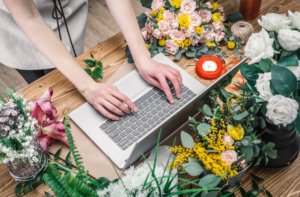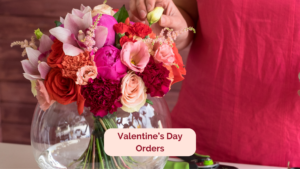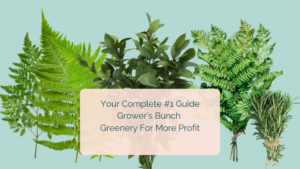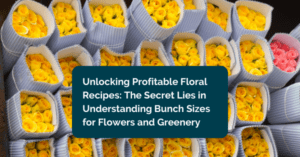Introduction: Maximize Your Floral Business Profit Margins
In this guide, you’ll learn actionable pricing strategies to improve your florist profitability with precise markups for:
- Fresh Flowers
- Hard Goods
- Rental Items
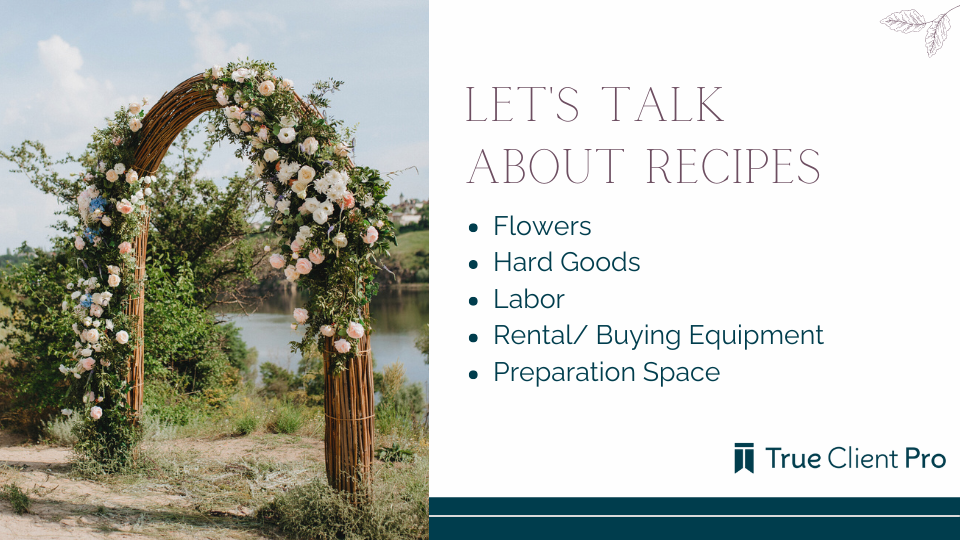
Plus, we’ll show you how to leverage True Client Pro to automate floral recipes, manage costs, and track profits effectively.
1. Why Markups Are Key to Florist Profitability
Markups allow you to cover wholesale costs, labor, and overhead while ensuring a fair take-home profit. Without proper markups, your business may struggle to scale or remain sustainable.
Standard Markups for Florists
- Fresh Flowers: 3.5x (350%) the wholesale cost
- Hard Goods (vases, ribbons, supplies): 2.5x (250%) the wholesale cost
- Rental Items: 2.5x (250%) the acquisition cost
Example:
If you purchase roses at $1 per stem, apply a 3.5x markup to sell them at $3.50 each. This markup accounts for perishability, labor, and cooler storage expenses.
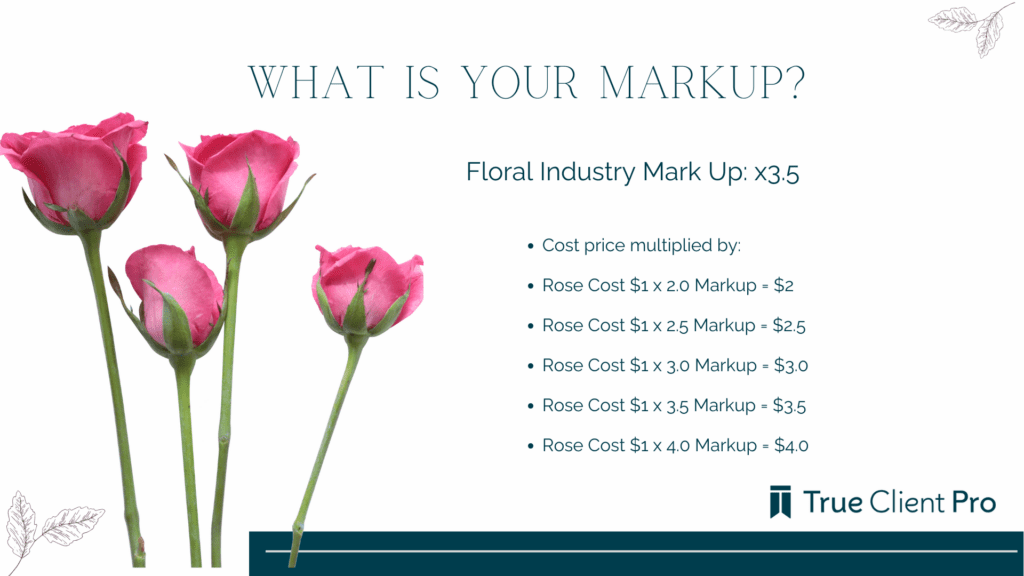
This visual example shows how markups at different multipliers impact pricing for fresh flowers like roses.
2. How to Price Rental Items Profitably
Rental items—such as arbors, vases, or props—are often overlooked but can boost profitability when priced strategically.
Rental Pricing Formula
When acquiring rental items, apply a 2.5x markup of the item’s acquisition cost.
Example:
If you purchase a custom wooden arbor for $300:
- Initial markup: $300 × 2.5 = $750.
Offset Your Investment:
- Rent for $250 per use = Break even in 3 rentals.
- Rent for $200 per use = Break even in 4 rentals.
Once the investment is recovered, subsequent rentals are pure profit.
3. Don’t Overlook Labor Costs in Your Pricing
Labor plays a significant role in pricing floral arrangements and ensuring profitability. Factor in the time spent on:
- Consultations and proposals
- Floral design and production
- Setup and strike-down at events
Designer and Assistant Rates
- Head Floral Designers: $50–$75 per hour (based on experience and location).
- Floral Assistants: Pay rates above minimum wage, reflecting their expertise.
- Freelancers: Charged hourly or per day, depending on the project scope.
4. Factoring Overlooked Costs Into Markups
Hard Goods:
Items like ribbons, pins, tape, and mechanics are small but essential. Overlooking these costs will erode your profitability. Include every expense, no matter how minor.
Overhead Costs:
For home-based studios or rented spaces, factor in:
- Rent or storage fees
- Utilities and maintenance costs
- Restocking and replenishing supplies
5. Streamline Pricing With True Client Pro Floral Software
Manually managing markups, labor, and rentals can be time-consuming and prone to errors. True Client Pro floral software simplifies the process by:
Providing detailed production reports to track profitability.
Creating accurate floral recipes.
Automating cost calculations for flowers, labor, and rentals.
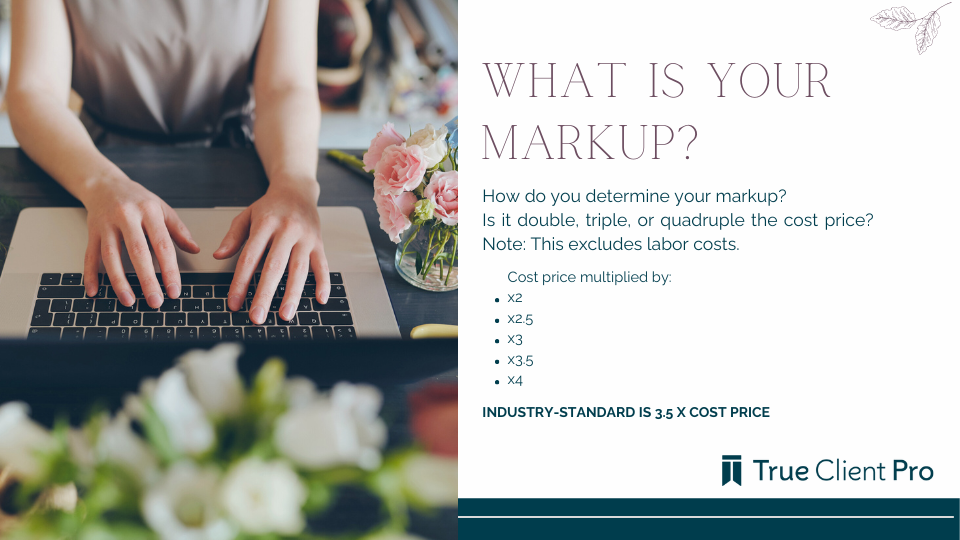
6. Strategic Pricing for Studios and Storefronts

Your workspace costs—whether home-based, rented, or a storefront—should directly influence your pricing strategy.
Factors to Consider:
- Home-based studio: Lower overhead costs.
- Rented space: Factor in rent and utilities.
- Storefront: Account for local market conditions and demographics.
Example: Allocate $200–$500 per event to cover overhead costs for studio or storefront expenses.
7. Tools to Streamline Pricing and Profit Margins
Modern tools like True Client Pro eliminate pricing guesswork and increase your profit margins by automating tasks like:
- Floral recipe creation
- Inventory tracking
- Cost calculation and production reporting
Key Benefits of True Client Pro:
- Saves time on manual calculations
- Reduces pricing errors
- Provides detailed worksheets for every arrangement
FAQs About Boosting Florist Profitability
- What is the standard markup for flowers?
3.5x the wholesale cost to ensure profitability. - How do I calculate rental pricing for event items?
Multiply the acquisition cost by 2.5. - How can I track costs for hard goods and fresh flowers?
Use True Client Pro to automate recipe management. - Why is labor cost important in floral pricing?
Labor reflects your time, expertise, and team wages. - How do overhead costs affect pricing?
Overhead like rent and utilities must be spread across all events. - What are commonly overlooked costs in floral pricing?
Hard goods like ribbons, foam, and cleaning materials. - What tools help improve florist profitability?
True Client Pro’s floral recipe and inventory tools. - How can I reduce flower wastage?
Streamline flower processing and use precise recipes. - How do markups differ for flowers and hard goods?
Flowers: 3.5x markup; Hard goods: 2.5x markup. - Why do florists undercharge for labor?
Many underestimate the time required for setup, design, and teardown.
Conclusion: Boost Your Florist Profitability Today
Improving your florist profitability starts with accurate markups and understanding your costs. By applying strategic markups for flowers, hard goods, and rentals, you ensure sustainable growth for your floral business.
With True Client Pro, you can streamline cost tracking, automate recipe calculations, and focus on delivering stunning floral arrangements that generate real profit.
Ready to boost your profit margins?
Sign up for True Client Pro today and transform how you price your designs!

